Acer P660 Portable Navigator Review
Acer P660 Portable Navigator
Can Acer's latest GPS device challenge the likes of TomTom?
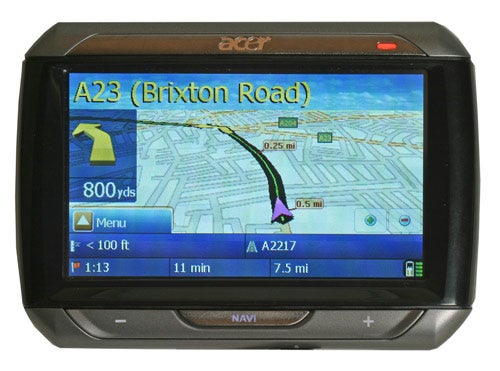
Verdict
Key Specifications
- Review Price: £299.00
As one of those companies that likes to have a finger in a lot of pies, it’s no surprise to see Acer offering GPS devices, even though it’s not one of the brand leaders. TomTom dominates in the retail market and due to the general excellence of its offerings it’s not hard to see why. However, Acer has a large presence in corporates, so IT managers may well care to consider Acer GPS products for its roaming workers.
Having seen two previous GPS products from Acer, neither of which were particularly convincing, it’s pretty much a case of third lucky. While the Acer d150 and Acer N35 were functional, the devices themselves had poor build quality and feel and the software on both was far from easy to use.
Design wise the P600 series navigator is a massive improvement over the frankly awful d150. It’s undeniably a really nice looking device, thanks to a pleasing 4in widescreen display and due to the fact that it’s thin, compared to something like a TomTom 510. Its dimensions are 116 x 81 x 23 mm (L x W x H) and it’s only 195g. This makes it eminantely pocketable, at least in a jacket pocket, which is just what you want. With GPS devices pretty much being the number one most stolen item from cars, once you leave your vehicle, your pocket is where you want it to be.
It’s not just the size and weight that works in its favour. The angular corners and the buttons all enhance the design. Beneath the screen are large, easy to press plus and minus volume buttons with a smaller button labelled ‘Navi’ between these. This enables you to switch between the navigation software and the main controls. The buttons are backlit and light up when the buttons are pressed or permanently when plugged in.
There’s an SD card slot on the right hand side, with a 256MB card supplied containing the CoPilot Live maps for UK and Ireland. Maps for Europe are also provided on CD and you can transfer them over onto the SD card by hooking up via USB cable. However, if you want more than the UK on the card at the same time you’ll need to purchase a larger SD card, though that’s no hardship seeing how cheap they are these days.
The P660 includes the Premium edition of CoPilot which offers full 7-digit postcode support for the UK, which in my view is essential. Another benefit of the top-of-the-range P660 is the bundled TMC receiver, more of which on later. 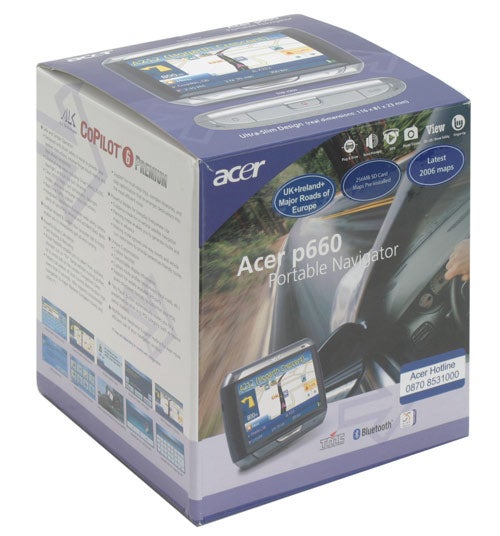
On the underside edge of the device is a mini USB device which is used for charging, and hidden by a plastic cover is a connector for an optional car mount kit. On either side of these are two slider switches for either hard or soft resetting of the device. These are quite deep inside and though I was told a stylus is included, one wasn’t supplied with my package. Either way, you should make sure that you have something that can access these switches as if your device does freeze up mid-journey, you’ll be stuck. This happened all the time with my very early sample, but once it was updated to the latest firmware it only occurred on one single occasion during my time with the device.
On the top edge of the device you’ll find the power button sensibly placed bang in the middle, with a headphone connector in one corner and a connector for an external GPS aerial in the other corner should you require it. These are both covered by hard flaps so you wouldn’t even know that they’re there. Round the back is the speaker, which is actually reasonably loud and clear.
Internally, the device is powered by a 400MHz Samsung S3C2440A processor, and has 64MB of RAM for system memory and another 64MB for the OS. Hmm, it’s almost as if it’s a Windows Mobile powered PDA. The GPS chip is the ubiquitous SiRFStar III. Software wise, the mapping data is provided by Navteq, which is considered to be a premium option.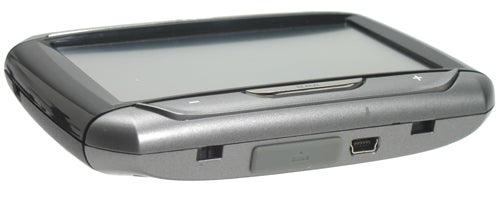
The only downside of the thin dimensions is that as a result the battery can’t be huge. It’s a 1,200 mAh Lithium Ion battery, but I got a battery low message after three hours. In any case, if you wish to use the TMC receiver supplied with the P660, you’ll need to keep the device plugged in with the car lighter socket charger.
From the Main screen you can launch the CoPilot navigation software, a built-in Photo viewer, an MP3 player and a Contacts database. It also contains a Settings button, and from here you can choose languages, adjust backlight settings and set the date and time. Oddly, you can also adjust the volume from here though why would anyone delve deep into this menu just to adjust the volume is beyond me, but the menu does provide you with the option to turn off the screen tap sound. 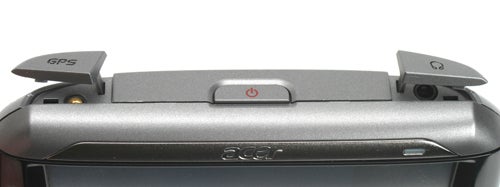
The extra abilities of the device aside from navigation is a clear indicator that it’s based on Windows Mobile 5. I do wonder if anyone would really want to carry round pictures on their GPS device. I can think of some uses – say an engineer off to a building site who wants to show designs without having to take a laptop. The photo interface isn’t that intuitive as you have to manually select each thumbnail to get it to display all of them in a slideshow. It does have some funky transitions though. The MP3 player is also quite basic, but with the device being so thin and it sporting a headphone socket, it is just about feasible to imagine that you could use it as an MP3 player.
One thing that impressed me straight away about the device was the screen quality, with colours quite vibrant. The first time you fire up the CoPilot navigation software it runs through a brief tutorial to get you started. All-in-all it’s a fairly easy to use device, though it does betray its Pocket PC origins at times.
Plotting a trip is quite straightforward. You press New Trip, and you can then enter and address or search via the all important postcode. You can also choose from a Recent list, which is useful as it removes the hassle of re-entering addresses again if it’s in the list.
Another way to enter a destination is via the Contacts tab, which pulls the addresses out of vCards. Active Sync is supplied with the Acer but for the life of me I could not work out why. I hoped to transfer all my contacts from Outlook but no matter what I did, Active Sync did nothing even though it recognised the Acer and synched. To get contact on there I had to copy them on to the SD Card as vcf files and manually import them – very clunky. Much to my amazement the Acer successfully pulled out the address and let me plot a route to it – the first time that I’ve seen a pocket PC based GPS device do this from the off. 
If you enter an address manually you get a non-Qwery keyboard with letters that fill the large screen. For some reason though to enter numbers you have to press the number screen and wait for that to come up than to enter the numbers. This is how regular Pocket PCs work but it makes no sense on a PDA when you are entering a postcode and have to switch between numbers and letters. The other issue was that the system is sluggish when you’re entering addresses, which makes the process tedious and almost impossible to do while the car is on the move – you’d spend too much time looking at the screen and you’ll most likely crash. Not good.
This delay is because of the smart address system, which predictively guesses what you’ll enter next. When you enter a postcode it enables only the letters that could possibly follow it. It’s a neat trick but you pay for it with a sluggish response. 
Once you’ve made each selection you need to press the next button, which is annoying. It’s elongated but surrounded by other buttons so it’s easy to miss it and muck things up, making the process take even longer. It all clearly betrays that the interface is optimised for use with a stylus like a PDA – and not for fat fingers in a car.
It’s also clear when you go into any screen with many options. To get to all of them you have to move the scroll bar on the right hand side down. Again, this makes sense on a PDA but not on this device. On a TomTom you move left and right to access further options via large easy buttons – not up and down via awkward to hit arrow keys. Despite this, as long as you’re not attempting to use it on the move though the Acer is still quite reasonable to navigate once you’ve got to grips with it.
The feature list is reasonable. There’s a list of favourites, and a Return Trip button, which does what it says on the tin and direct you back from where you came, without you having to key in a location.
If you do attempt to route to an address when you’ve not got GPS coverage it asks if you’d like to route from your last location or to wait for a GPS signal. How polite.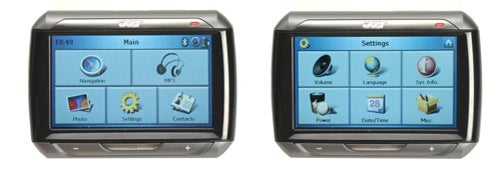
A Menu button sits at the bottom left, that then pops up vertically, and gives you access to other functions such as Views. From here you can choose to view 3D modes or itinerary, which lets you see each stage of you journey in text mode and choose to avoid parts of it. Keep delving in here and you’ll find a Mode button that lets you switch between Guidance, Planning and Walking mode.
Unfortunately, I found the Planning mode difficult to use while the Walking mode didn’t really do anything to speak off. It showed the path to where I was going in a large thick pink line but whenever I tested it in this mode my location didn’t change.
The Point of Interest database works in a different way to the ones I’ve used on other devices. Rather that moving exclusively through categories the best way is to search for what you’re looking for and then narrow the search down to looking near a city. There are categories but rather than presenting them all in a drop down menu so you can choose one, you can only see them one at a time, which is very poor. However, with perseverance I did manage to get it to locate all the numerous locations I tried, so I can’t be too critical. It’s all there, it’s just a pain to find it.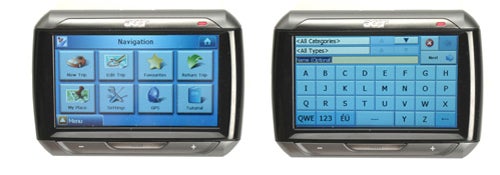
The other option that many will be looking for is the traffic feature. This is provided by the TMC add on. You plug in the receiver into the bottom of the device and the power cable then goes into that. TMC (Traffic Message Channel) signals are broadcast over FM radio, which the GPS unit can pick up and integrate into your planned route, automatically re-routing you round blockages. It’s sounds great in theory with the advantage over TomTom Traffic in that you don’t have to subscribe to a traffic feed. However, I found two major problems with it. Firstly, as well as requiring the external TMC receiver you also have to run an aerial cable round the edges of your windscreen. Two rather puny suction cups are provided and it’s awkward to fit and frankly unsightly. Secondly, it just doesn’t work that well. I did manage to pick up some reports on the first day I tried it but it failed to pick up other a major incident that was being announced on all the Traffic news reports. On another occasion I was sitting in traffic on the M25 et no traffic blockages were reported. I simple would not trust it to really help me on a long term basis.
The P660 also includes a speed camera database and this is shown with a yellow box that reports the speed limit and your current speed along with a distance count down – nicely done. Unfortunately, it wasn’t up to date, and was missing several cameras that I passed.
The on screen display is good with a highly customisable sections that sit underneath the map that can display information such as the name of road your on, the destination, the current time and your ETA.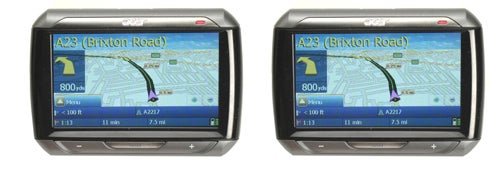
The actual 3D display is reasonably clear, with a blue arrow for your car over a red line displaying the route. The widescreen display means that there’s room for a next turn arrow on the left side of the screen with plenty of room for the map on the rest of the screen. A safety mode kicks in replacing the map view with a simple arrow and instruction and this can be set to kick in at a speed of your choice.
Overall, I enjoyed using the Acer P660. It did its job and got me to destinations that I wasn’t familiar with without fuss with the female voice giving clear. While the navigation software itself is good, navigating the device itself takes some getting used. My biggest gripes was the sluggishness when searching, the need to scroll up and down to reach all the options and the disappointing performance of the TMC unit. In the end, it’s the latter that would prevent me from buying one over a TomTom, as I have found its TomTom traffic service provided over mobile phone and Bluetooth to a more effective and elegant solution.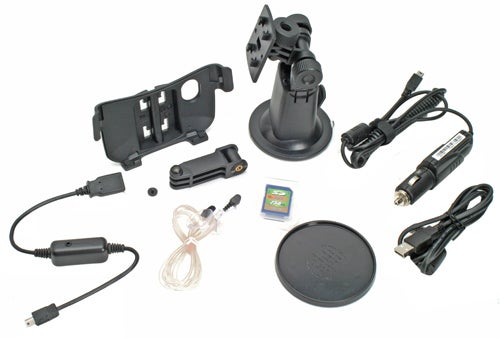
Price wise the Acer P660 is well positioned, coming in at the same as a TomTom 510 with TMC from Dixons, with the advantage of offering maps for all of Europe on CD, compared to just the UK and Ireland with the 510. In terms of unit design and the look and feel of the software it’s a huge step forward over Acer’s previous units but there’s still plenty of room for improvement in terms of the interface design.
”’Verdict”’
Acer keeps persevering with sat-nav and the good news is that the products are getting better. The P660 is thin, light and good looking, but it’s also sluggish and still falls behind a TomTom for ease-of-use, while toe performance of the TMC is disappointing.
Trusted Score
Score in detail
-
Value 8
-
Features 8
-
Usability 6

